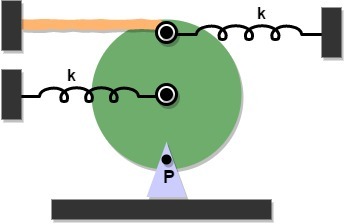Simple Harmonic (5).

A thin uniform disc of mass and radius is hinged at its lowest point and placed in a gravity-free space. It is attached by two identical and ideal springs of force constants each and a string of cross-sectional area , length and Young's modulus at the positions shown in the figure (centre, top and top). The springs are currently in their natural lengths, the string is unstretched and the whole system is in equilibrium. The disc is given a small angular displacement about the hinge and allowed to oscillate freely. If the time period of the small oscillations can be expressed as
where and are pairwise coprime positive integers and and are both square free. Find .
The answer is 21.
This section requires Javascript.
You are seeing this because something didn't load right. We suggest you, (a) try
refreshing the page, (b) enabling javascript if it is disabled on your browser and,
finally, (c)
loading the
non-javascript version of this page
. We're sorry about the hassle.